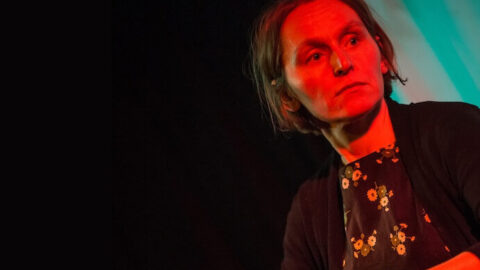The word ‘unique’ is used on the flimsiest of pretexts to describe an artist, but for Sarah Angliss it is truly merited. It’s unusual enough to encounter a composer who is also a theremin player, an instrument designer, and a performer on different recorders: she is all three of these and much more besides. And I haven’t even mentioned Hugo, a converted ventriloquist’s doll who often shares a stage with her, acting as a visual focus for an otherwise disembodied recorded voice. It speaks volumes that when I first encountered Sarah Angliss as live performer–in the Daylight Music series at Union Chapel, London–I was blown away more by the quality of her music than by her automata and instrumental novelties.
Her gig at Kings Place, London on 30 March 2019 was part of a tour launching her new album, Air Loom. Angliss shared the stage with regular collaborators, percussionist Stephen Hiscock and soprano Sarah Gabriel, as well as a myriad of instruments. For this set, the retro electronica included two red dial telephones as well as a theremin and a splendid robotic carillon, the ‘Ealing Feeder,’ that can play faster than any human virtuoso. Hiscock stood at one side of the stage behind a metallophone and an array of bells hanging from a frame, but pride of place went to a clavisimbalum, a jangly psaltery made in Riga, Latvia which Angliss describes as ‘a sonorous, fourteenth-century cousin of the harpsichord’ with ‘murk in the sound.’
Angliss originally trained as an electroacoustic engineer, while also singing in folk clubs, and this dual background continues to inform her artistic practice. She is part of a distinguished line of British women in electronic music, and indeed recently wrote an introduction to a new edition of electronics pioneer Daphne Oram’s book An Individual Note: of Music, Sound and Electronics (1972). Oram was co-founder and first director of the BBC Radiophonic Workshop, and Angliss, together with Tom Richards and Shiva Feshareki, has written for Richards’ realisation of her mini-Oramics synthesiser, which converts drawn images into sound.

Resonance is central to Angliss’ music, both literal and metaphorical, as suggested by the punning title Air Loom: something valuable is passed on through the ages and woven in space. But the Air Loom was also a sinister invention of the early 19th century, ‘a mind control device capable of remotely manipulating and influencing the thoughts of its intended victim.’ Could the insinuating qualities of Angliss’ theremin and waterphone sonorities bend our minds? Whatever, hers is music which is contemporary, often referencing districts in London, and yet also exists in its own time, rooted in a folk tradition which for most people in the UK doesn’t really exist. Drawing on tales both traditional and invented, Angliss combines live sounds, which are often looped or echoed, with recordings, confronting the acoustic with the electronic.
Angliss is a reserved stage presence, though she introduced many of the numbers in a dry, witty manner, emphasising the everyday humanity which pokes through the strange surface of her music. Hiscock was an unobtrusive presence behind a large ensemble of bells of all shapes and sizes hanging from a frame. However, he was the focal point for Sky Bullion, a drumkit with recorded sounds of buildings being demolished, which was a rare loud uptempo moment in the set: what percussionist doesn’t want a drumkit solo? The strongest stage presence of the night was Sarah Gabriel, a new music specialist and actor whose largely vibrato-free, crystal-clear delivery added a sharp, communicative edge to the mysterious texts.
The set included several tracks from Angliss’ first solo album Ealing Feeder (2017). The unblinking Hugo provided an unsettling narration in A Wren in the Cathedral, where Angliss’ looped treble recorder and theremin dialogue with recorded birds and traffic-laden streetscapes. Layers of bells, both Hiscock’s virtuoso bellringing and the robot carillon, were central to Camberwell Beauty, with the clavisimbalum adding a delicate, twangy timbre, though the robot had the last word. Like many of Angliss’ tracks, Camberwell Beauty speaks of the familiar made strange, as if a folk song had been discovered unexpectedly in an urban environment.

Angliss’ newer material was, if anything, even more unsettling. A telephone rang, then another, to be answered by Hiscock’s multitude of bells and Angliss’ theremin in strangely tempered counterpoint as Gabriel intoned an enigmatic folklike song about ‘the ground where dead men sleep.’ Themes of death and the destruction of nature are omnipresent in Angliss’ music, a world where human and acoustic fragility is constantly juxtaposed with the electronic and robotic. Dust, her response to the 50th anniversary of the Moon landings, focuses on the banality of the dialogue between the astronauts and those on the ground, surrounding their words with a murky halo of clavisimbalum, recorded sounds and bell tremolos.
Sarah Angliss’ music is most notable for its extraordinary aural imagination and unsettling, uncanny quality. It is not surprising to hear that she is composer and sound designer for a stage production of the Twilight Zone which is currently playing at the Ambassadors Theatre in London. Who knows what sounds might be lying underground in my London district? I get the feeling that Sarah Angliss knows…
























